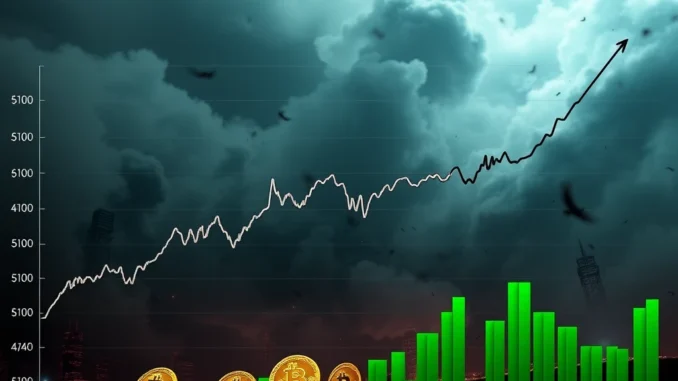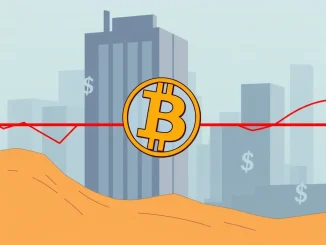
Hold onto your hats, crypto enthusiasts! The market is sending some serious signals. The relationship between Ethereum and Bitcoin, often seen as a barometer for the altcoin market’s health, is flashing red. The ETH/BTC ratio has just plummeted to levels we haven’t seen since late 2020. This significant drop coincides with another concerning metric: Bitcoin’s four-year compound annual growth rate (CAGR) hitting a record low. Are these merely temporary dips, or are we looking at a deeper shift in the crypto landscape? Let’s dive into the data and unpack what this could mean for your portfolio.
Why is the ETH/BTC Ratio Plunging and What Does it Indicate?
The ETH/BTC ratio is a crucial metric for many crypto traders and investors. It essentially measures the value of Ethereum against Bitcoin. A rising ratio suggests Ethereum is outperforming Bitcoin, often indicating a healthy appetite for riskier altcoins. Conversely, a falling ratio, like we’re seeing now, typically signals a flight to safety, with investors preferring the perceived stability of Bitcoin.
The current drop to 0.022 is noteworthy. To put it in perspective:
- Historical Context: This level takes us back to the pre-bull run days of late 2020, before the massive crypto surge of 2021.
- Market Sentiment: It suggests a significant cooling off in altcoin enthusiasm and a preference for Bitcoin, potentially driven by broader economic uncertainties or specific concerns about the altcoin market.
- Risk Aversion: A lower ETH/BTC ratio often correlates with increased risk aversion in the crypto market. Investors are choosing the ‘original’ cryptocurrency, Bitcoin, over its arguably riskier counterparts like Ethereum.

ETH/BTC Ratio Chart Showing Decline to 2020 Levels (Source: Glassnode)
Bitcoin’s Alarming Four-Year CAGR: A Cause for Concern?
Adding fuel to the fire, Bitcoin’s four-year compound annual growth rate (CAGR) has also hit a record low of 8%, according to data from Glassnode. For those unfamiliar, the four-year CAGR is significant in Bitcoin circles because it aligns with Bitcoin’s halving cycle. Historically, each halving event (where mining rewards are cut in half) has been followed by a bull market. This four-year cycle has been a cornerstone of many Bitcoin investment strategies.
Why is an 8% four-year CAGR worrisome?
- Historical Norm: Bitcoin’s four-year CAGR has typically been much higher, reflecting its high-growth nature in previous cycles. An 8% figure is significantly below historical averages.
- Maturity Concerns: Some analysts interpret this low CAGR as a sign that Bitcoin is maturing as an asset class, potentially leading to lower growth rates compared to its early, more volatile years.
- Economic Headwinds: Broader macroeconomic factors, such as rising interest rates and inflation, could be impacting Bitcoin’s growth potential in this cycle.
However, it’s crucial to remember that past performance is not indicative of future results. While a low Bitcoin CAGR might raise eyebrows, it doesn’t necessarily spell doom for Bitcoin or the crypto market.
Extreme Market Fear and Surprising Spot Accumulation: A Paradox?
Interestingly, despite the concerning metrics of the ETH/BTC ratio and Bitcoin CAGR, market sentiment is described as being at ‘extreme fear’ levels. This is often measured by indicators like the Fear & Greed Index, which reflects the general emotional temperature of the crypto market. Extreme fear can sometimes be a contrarian indicator, suggesting that the market might be oversold.
Adding another layer of complexity, data indicates that spot accumulation of Bitcoin is continuing. This means that despite the fear and negative price action, some investors are still buying and holding Bitcoin in anticipation of future price increases. This divergence between market sentiment and on-chain activity is intriguing.
Could this spot accumulation be setting the stage for a future price rebound? Potentially, yes. Here’s why:
- Foundation for Recovery: Spot accumulation provides a base of demand. If accumulation continues while prices remain low, it reduces the available supply and can create upward pressure when buying interest returns.
- Futures Market Catalyst: The article suggests a ‘futures market-driven price rebound’ is possible once accumulation is complete. This implies that a short squeeze could be triggered.
- Short Squeeze Potential: If many traders are betting against Bitcoin (short positions) and the price starts to rise, they may be forced to buy back Bitcoin to cover their positions, further accelerating the price increase – a classic short squeeze.
Is a Rapid Price Reversal Imminent? Don’t Get Overheated!
While the pieces are potentially in place for a price rebound, it’s crucial to temper expectations. The subdued market sentiment suggests that an ‘overheated rally’ is unlikely. In other words, don’t expect a parabolic moonshot immediately. However, a ‘short squeeze’ scenario could indeed trigger a rapid price reversal.
What should you watch for?
- Futures Market Activity: Keep an eye on Bitcoin futures markets. A sudden increase in price accompanied by high trading volume could signal the start of a short squeeze.
- Sentiment Shift: Monitor market sentiment indicators. A shift from ‘extreme fear’ towards neutrality or even ‘greed’ could indicate renewed buying interest.
- ETH/BTC Ratio Stabilization: While a sharp reversal in the ETH/BTC ratio might not be the immediate trigger, stabilization or a slight upward movement could suggest improving altcoin market conditions.
Actionable Insights and Takeaways: Navigating the Current Crypto Landscape
So, what does all this mean for you as a crypto investor or trader? Here are some actionable insights:
- Stay Informed: Keep a close watch on key metrics like the ETH/BTC ratio, Bitcoin CAGR, and market sentiment indicators. Data-driven decisions are crucial in volatile markets.
- Assess Risk Tolerance: The current market conditions highlight the importance of understanding your risk tolerance. Are you comfortable holding through potential further downturns, or should you consider adjusting your portfolio?
- Consider Spot Accumulation: If you believe in the long-term potential of Bitcoin and Ethereum, the current market conditions might present a buying opportunity for spot accumulation, especially if you are a long-term holder.
- Manage Expectations: Be realistic about potential price movements. While a short squeeze-driven rebound is possible, don’t expect a return to bull market euphoria overnight.
Conclusion: Cautious Optimism in a Fearful Market
The current crypto market is undoubtedly complex and filled with uncertainty. The falling ETH/BTC ratio and low Bitcoin CAGR paint a concerning picture, reflecting widespread market fear. However, the continued spot accumulation offers a glimmer of hope, suggesting a potential foundation for a future price rebound. While an immediate, explosive rally is unlikely, a short squeeze-driven price reversal remains a distinct possibility. Navigating this landscape requires a balanced approach – acknowledging the risks while being open to potential opportunities. Stay informed, manage your risk, and remember that in the world of crypto, volatility is the name of the game. This period of ‘extreme fear’ could very well be the precursor to the next cycle of growth and innovation in the crypto space. Keep your eyes peeled and your strategies sharp!



